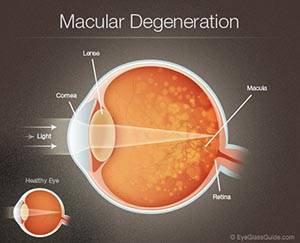
What is AMD?
The most common cause of loss of vision is associated with aging, this eye disease is known as age-related macular degeneration (AMD).
There are two forms of this disease, wet macular degeneration and dry macular degeneration. Both forms affect the central portion of the retina, which is the light-sensitive section located in the back of the eye. This part of the eye processes images and is essentially responsible for sight.
The main symptom of Macular Degeneration is slowly losing vision in the central part of sight. This loss precludes the ability to do many everyday activities, including reading and driving. It also reduces your ability to see details, impacting the clear vision required for looking at photographs, enjoying entertainment and even watching TV.
Statistics
The dry form of AMD is more common than the wet form. In fact, almost 90% of AMD is the dry form.
The leading cause of losing vision in people over 50 years of age is macular degeneration. The risk of AMD increases with age. The disease affects over 4% of the population from age 75 to 79 and then jumps to over 14% for those over the age of 80.
There are various risk factors, including smoking, obesity, and exposure to UV rays. Additionally, macular degeneration affects women in greater numbers than men and also has a strong genetic component.
Macular Degeneration can cause low vision and debilitating vision loss, even blindness if not diagnosed and treated in the early stages. Because the disease often has no obvious symptoms early on, it is critical to have regular comprehensive eye tests, particularly if you are at risk.
Symptoms of AMD
Macular degeneration is a disease in which the macula slowly breaks down, resulting in a gradual progressive vision loss, at least in its’ early stages. Frequently there are no symptoms and the disease is only diagnosed when a doctor detects signs such as a thinning macula or the presence of drusen in a comprehensive eye test.
Early vision loss can include blurry, cloudy or distorted central vision or dark spots in your central field of view. With advanced stages, vision loss can be severe and sudden with larger blind spots and total loss of central vision.
